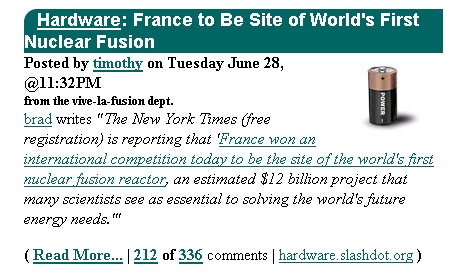;
Travels and Images
WEEK 26 2005
Last Week-
Sun- Mon- Tue- Wed- Thur- Fri- Sat- Next Week
Picture of the Week
MAIN PAGE
Saturday 2 July
2005
Saturday
-
Friday
1 July
2005
Friday - off to the
beach shortly. Then up to my Dad's for the fourth.
Some Friday puppy blogging!

Teegan.
Friday tokamak blogging.

ITER Fusion Reactor. Looks like they are
finally serious about this stuff...
Thursday 30 June 2005
Thursday
- so much for the supreme court. Heh.
But why stop with just one justice?
On to other,
more serious topics: why does The
Oasis, 105.5 play "Raspberry Beret"
by Prince every single day. Every. Single. Day. I kid you not.
I hate that song. I've always hated that song. Mostly
because I hate Prince, but also because the song itself stinks.
And why is there a "p" in Raspberry? Does
anyone actually say "Rasp"-"berry"?
Yummmm....Raspberry pie....
In other
musical news: someone has compiled a list of Horribly
Depressing Songs. The memorable "Honey" makes the list:
3. Honey Bobby Goldsboro (1968)
The world's wordiest dead wife song, Honey is jammed full of blooming
flowers, puffy clouds, singing robins, planted trees, and a puppy, all
of which just make you want to swallow a hand grenade.
but was beaten out by "The Christmas Shoes" for first place!
The Christmas Shoes is smug, saccharine and more depressing
than the Cure's entire career.
Heh. I've heard TCS, and it really is
that bad. The country western stations love
it. [via Ghost of a Flea]

Speaking of puppies, my friends are very-tiny-puppy-sitting (and bird
sitting) this week...
Did you
know that Archibald 'Moonlight' Graham, portrayed in Field of Dreams by
Burt Lancaster, was a
real person? [ via Geek Press ]
Wednesday
29 June 2005
Wednesday - did a nice long walk this
morning. My copy of 'A Modern Course in Aeroelasticity, 4th
Edition' arrived yesterday. It seems to have a great deal more in the
way of computational aeroelasticity, non-linear aeroelasticty, and
controls as applied to aeroelasticty. I'm looking forward to looking
through it.
I see that Slashdot has another bad headline for an article about
fusion energy:
 Slashdot headline
Slashdot headline.
The headline is wrong because this event has happened already:
The 'mushroom cloud'
from the first (Ivy Mike) fusion bomb
I'm pretty sure that there has been, in any cast, a fusion reactor - a
tokamak or whatever - that produced net power, if only for a short
while. I can't find the reference right now though.
In any case, all these physics geek's could apparently save a lot of
money by going to ebay:
 A targeted ad,
while searching on Yahoo!
A targeted ad,
while searching on Yahoo!
The rattlesnake flag pictured Tuesday, is known as the Gadsden Flag,
and it has an very
interesting history. Drunken Cretins, heh.
Kelo vs. City of New London, continued, (and I promise to stop after
this):
First Some Humor
from Scrappleface:
Court Allows 10 Commandments on Seized Land
by Scott Ott
(2005-06-27) -- In a pair of rulings on
the constitutionality of the 10 Commandments on
government property, the Supreme Court today said the commandments
may be displayed on public land if that property has been seized from
private owners for 'public purposes' under eminent domain.
The 5-4 decision
comes on the heels of last week's court declaration that so-called "private" property is
actually government land temporarily under private management until its
eventual seizure.
The majority's actual opinion,
delivered by Justice Stevens. I don't find it as readable as the
dissent, and it may
be that "dissents" are more exciting by their nature, but basically it
indeed says that "public use" really means the
broader and more natural interpretation of public use as
“public purpose.”, here is a relevant bit:
Two polar propositions are perfectly
clear. On the one hand, it has long been accepted that the
sovereign may not take the property of A for the sole
purpose of transferring it to another private party B,
even though A is paid just compensation. On the other
hand, it is equally clear that a State may transfer property
from one private party to another if future “use by the
public” is the purpose of the taking; the condemnation of
land for a railroad with common-carrier duties is a familiar
example. Neither of these propositions, however, determines
the disposition of this case.
As for the first proposition, the City
would no doubt be forbidden from taking petitioners’ land
for the purpose of conferring a private benefit on a particular
private party. See Midkiff, 467 U.S., at 245 (“A
purely private taking could not withstand the scrutiny of the
public use requirement; it would serve no legitimate purpose of
government and would thus be void”); Missouri Pacific
R. Co. v. Nebraska, 164
U.S. 403
(1896).5
Nor
would the City be allowed to take property under the mere
pretext of a public purpose, when its actual purpose was to
bestow a private benefit. The takings before us, however,
would be executed pursuant to a “carefully
considered” development plan. 268 Conn., at 54, 843
A. 2d, at 536. The trial judge and all the members of the
Supreme Court of Connecticut agreed that there was no evidence
of an illegitimate purpose in this case.6
Therefore, as was true of the
statute challenged in Midkiff, 467 U.S., at 245, the
City’s development plan was not adopted “to benefit a
particular class of identifiable individuals.”
On the other hand, this is not a case
in which the City is planning to open the condemned
land–at least not in its entirety–to use by the
general public. Nor will the private lessees of the land in
any sense be required to operate like common carriers, making
their services available to all comers. But although such a
projected use would be sufficient to satisfy the public use
requirement, this “Court long ago rejected any literal
requirement that condemned property be put into use for the
general public.” Id., at 244. Indeed, while many
state courts in the mid-19th century endorsed “use by the
public” as the proper definition of public use, that
narrow view steadily eroded over time. Not only was the
“use by the public” test difficult to administer
(e.g., what proportion of the public need have access to
the property? at what price?),7
but it proved to be impractical given the
diverse and always evolving needs of society.8
Accordingly, when this Court
began applying the Fifth
Amendment to
the States at the close of the 19th century, it embraced the
broader and more natural interpretation of public use as
“public purpose.” See, e.g., Fallbrook
Irrigation Dist. v. Bradley, 164
U.S. 112,
158—164 (1896). Thus, in a case upholding a mining
company’s use of an aerial bucket line to transport ore
over property it did not own, Justice Holmes’ opinion for
the Court stressed “the inadequacy of use by the general
public as a universal test.” Strickley v.
Highland Boy Gold Mining Co., 200
U.S. 527, 531
(1906).9
We
have repeatedly and consistently rejected that narrow test ever
since.10
Some Other Opinions:
Orin Kerr, who disagreed with the decision, posted:
1. The opinions in Kelo remind me a lot of
the opinions in Gonzales v. Raich. The Court has
once again reaffirmed the academic common wisdom — in Raich, that the commerce
clause power is virtually limitless, and in Kelo,
that almost everything is a public use. Both cases involved the same
type of line-drawing challenge, in which the Constitution requires a
line to be drawn but it's pretty hard to draw such a line in practice.
(It's difficult to distinguish interstate commerce from intrastate
commerce and commerce from non-commerce, and it's difficult to
distinguish public use from private use.) In both cases, the Stevens
majority opinion recognized that a line existed in theory, but put it
so far out of the way that it won't bother anyone.
(emphasis mine.)
On the other hand, lawyer
blogger Ann Althouse agrees with the decision, and apparently
thinks that there is a clear line ( or perhaps a warning of a future
line?) and gets 106 comments on her post:
There
is a message here for local government: if you go further than the City
of New London did in Kelo, you will get tied up in legislation.
A line drawing challenge indeed,
when two lawyers already disagree. I have to say:
thinking of it as a "full employment act" for lawyers and judges hasn't
ameliorated the pain a bit. Bah.
Tuesday 28 June
2005
Tuesday - my sister talked to a local
wildlife expert. His take: it wasn't
a diamondback rattlesnake, because there are none in northern Nevada.
So, judging from her description, the expert said that it was probably
a harmless (to humans, anyway) ground snake of some sort. However,
there are rattler's about,
their markings being rather dull and nondescript. So, I think that my
advice about education is still apt.
Another of my sibling's wrote that, in their understanding, the venom
in younger and smaller snakes is indeed no stronger, but that they lack
the control (experience?) to inject just a small amount of venom.
Possibly, but I would think that even an experienced snake would use
the maximum amount of venom (if it could) when confronted with
repulsing a creature as large as a human. Even a child of 50 or 60
pounds has a weight dozens of time's larger that of even a good sized
snake. So, big or small, you are likely to get just as sick.

Applicable to the paragraphs above, and below.
Kelo vs. City of New London
Kelo is a case where a city
used the power of eminent domain to seize a number of homes, including
Charles and Suzette Kelo's.
Generally we are used to this power being used to do things like route
roads, train tracks, to build dams & airports, to create city,
state, and national parks, and so on. All governments reserve this sort
of power to themselves - the US is no different than any other here.
This power is outlined in the Constitution, as I understand it, in the Takings Clause
of the Fifth Amendment:
“No person shall be held to answer for a capital, or
otherwise infamous crime, unless on a presentment or indictment
of a Grand Jury, except in cases arising in the land or naval
forces, or in the Militia, when in actual service in time of
War or public danger; nor shall any person be subject for the
same offence to be twice put in jeopardy of life or limb, nor
shall be compelled in any criminal case to be a witness against
himself, nor be deprived of life, liberty, or property, without
due process, of law; nor shall private
property be taken for
public use, without just compensation.”
(Emphasis
added.)
The argument turns on what "public
use" means.
- Suppose the Federal Government wanted Suzette Kelo's property for
a naval base. Most would agree that is acceptable, though regrettable
for Ms. Kelo.
- Suppose the State Government wanted her property, so as to
provide a thoroughfare for a private railway. This is a little
trickier, since it is a transfer to a new owner that is not the public,
but since railway lines are generally considered 'common carriers' and
the public can use them, this is considered acceptable.
- Suppose the Country Government wanted her property, to
build a baseball stadium on. Again, even though it is a transfer to a
private organization, the public, as a whole, can use it, and many -
but not all - consider it acceptable. For example, people still argue
to this day about the taking of Chavez Ravine in Los Angles to build a
stadium for the Los Angeles ( nee Brooklyn) Dodgers.
- The City of New London states specifically that they want the Kelo
property so that a business park can be built in place of her home;
thus increasing the number of jobs in the city, and to get increased
tax revenues from the new owner. Is this a valid public use?
The Supreme Court said "yes",
in a split decision, 5:4.
Here is the dissent of Justice Clarence Thomas.
It's actually quite readable - perhaps it is my late blooming interest
in American History, but I found it thoughtful and interesting. Here
are the first two paragraphs:
Justice
Thomas, dissenting.
Long ago, William Blackstone wrote
that “the law of the land … postpone[s] even public
necessity to the sacred and inviolable rights of private
property.” 1 Commentaries on the Laws of England
134—135 (1765) (hereinafter Blackstone). The Framers
embodied that principle in the Constitution, allowing the
government to take property not for “public
necessity,” but instead for “public use.” Amdt.
5. Defying this understanding, the Court replaces the Public
Use Clause with a “ ‘[P]ublic [P]urpose’ ” Clause, ante, at 9—10 (or perhaps
the “Diverse and Always Evolving Needs of Society”
Clause, ante, at 8 (capitalization added)), a
restriction that is satisfied, the Court instructs, so long as
the purpose is “legitimate” and the means “not
irrational,” ante, at 17 (internal quotation marks
omitted). This deferential shift in phraseology enables the
Court to hold, against all common sense, that a costly
urban-renewal project whose stated purpose is a vague promise
of new jobs and increased tax revenue, but which is also
suspiciously agreeable to the Pfizer Corporation, is for a
“public use.”
I cannot agree. If such
“economic development” takings are for a “public
use,” any taking is, and the Court has erased the Public
Use Clause from our Constitution, as Justice O’Connor
powerfully argues in dissent. Ante,
at 1—2,
8—13. I do not believe that this Court can eliminate
liberties expressly enumerated in the Constitution and
therefore join her dissenting opinion. Regrettably, however,
the Court’s error runs deeper than this. Today’s
decision is simply the latest in a string of our cases
construing the Public Use Clause to be a virtual nullity,
without the slightest nod to its original meaning. In my view,
the Public Use Clause, originally understood, is a meaningful
limit on the government’s eminent domain power. Our cases
have strayed from the Clause’s original meaning, and I
would reconsider them.
Down towards the bottom there is this line:
Something has gone seriously awry
with this Court’s interpretation of the Constitution.
An Aside:
You can get this opinion on a T-shirt!

Click image to order your T-shirt today!
Another
aside:
If you are, as I am, a fan of the "Sackett" westerns, then you will
recognize the references to "Blackstone" as being a famous and
important book of law that various cowboy's carried in their
saddlebags, and read around the campfire for self improvement.
Notes:
I often go to Instapundit,
which is a law professors blog, so some of these
references I probably found there. Here is an
early, June 23rd, archive roundup posting.
Many others are from The Volokh
Conspiracy, which is a group blog of lawyers.
There is a web page, Scotusblog,
( SCOTUS being an acronym for Supreme Court Of The
United States)
that has recently been created. It contains numerous posts - mostly by
lawyers - on the various recent court decisions.
Monday
27 June 2005
Monday - in an synchronic incident, Exclamation Mark
has a link to a website Photo's of Pregnant
Animals
that contains, well, pictures of pregnant animals. All sorts of
animals. Pregnant flying bats. Weird. So I am sending them my picture
of the pregnant Antelope
Squirrel from last week.
Now I'm part of the weirdness.
I received an email written by my sister, who thinks that she may have
seen a small western
diamondback rattlesnake in her backyard. She has a small child, so
this is a not unreasonable thing for her to worry about...
My response was, basically, that education was her best choice:
XXXX,
I got your email, forwarded from Dad.
Mike and I have seen small rattler's on our hiking trips, and the
rattle is VERY noticeable. If you didn't hear it, then it may well have
been one of those impersonator snakes, that try to look fierce to scare
off birds and coyotes. (I forget the exact scientific term, but you get
the drift)
If I had a young child the above wouldn't make me feel particularly
safe - because it could easily have been a venomous snake - probably a
visit to
a local nature park to familiarize ZZZZ with them and to remove the
attraction of the unknown might help? I'm sure there ARE rattler's
about, in desert country, so it's probably a good idea.
I'm not sure what else to tell you, except that snakes really don't
want to mess with people. The rattle is to force you to hesitate so
that they can get away.
I have read that smaller snakes are NOT more venomous than big snakes,
it's just one of those urban legends.
I've been walking in the desert about here, taking pics of various
creatures. Birds, squirrels, rabbits, and so on. It's funny, once you
start looking for photo opportunities, there seem to be a lot more of
them. I don't have the photographers trained eye, but I can see how it
would eventually develop.
love,
I haven't said much about the recent Supreme Court rulings, because,
well, I am no lawyer and who cares what I say? But I do find them very
disturbing.
Ashcroft vs. Raich
A recent case was 'Ashcroft vs. Raich',
where the federal government was going after people growing marijuana
at home for medicinal purposes ( yeah, right.). It's interesting to me
because I've wondered for a while why the feds could pass drug laws
prohibiting almost anything now, but had to have a
constitutional amendment prohibiting alcohol way back when.
The answer is simple: control of interstate commerce was
already extant in the Commerce Clause
of the Constitution, specifically placed there to avoid problems with
interstate tariffs and tolls that had plagued the Confederation of
States. The Supreme Court made a ruling in the case of 'Wickard vs
Filburn' in 1940 that intrastate
commerce (wheat farming, even if not grown for sale!) could
affect interstate commerce
(since the farmer therefore might not buy wheat that might have been grown out of state!),
therefore it was controlled as well. (More detail here.)
The current ruling ( Gonzales is the current attorney general of the
United States, but the case started under Ashcroft ) extends that
ruling even further - pot, a substance that cannot by law be sold in
commerce, that was grown by and consumed on the premises of an
individual under the direct supervision of the State of California, is
now classed as 'interstate commerce'.
I should probably say that I have no big problem with drug laws in
general, but find this distortion and expansion of the law very
disturbing. What, now, is the limit to the reach of such a law?
I don't like 'slippery slopes' arguments, but the historical record is
clear - you can read it at the link above - after about a hundred years
of fairly strict constitutionalism the succeeding courts have given
this one small line increasing amounts of power and influence, until we
get decisions like Raich. One can argue that the federal government needed this power, that it has been
used mainly
for good, and so on. But, even granting this, it seems to me that it is
up to the various congresses and states to legislate this power into
existence, at the behest of (or at least with the permission of), the
voters, rather than for a few lawyers to conjure it up out of thin air,
good intentions not withstanding.
Sunday 26 June
2005
Sunday - can't say that I did a lot.
Picked up a larger flash memory card for the OptioWP at Costco, and a
couple of other items.
Also I went to see 'Batman
Begins'.
It was fun, fairly well done. The actor playing Batman, Christian Bale,
did a good job, and the token romantic interest was played by Kate
Holmes, in what amounts little more than a bit part. Michael Caine had
a much bigger part as Alfred, the butler.
The audience liked the movie as well - they clapped
at the end. Odd, it never occurred to me to do that but it was
apparently spontaneous with others - I can't remember the last movie I
heard that
happen in.










